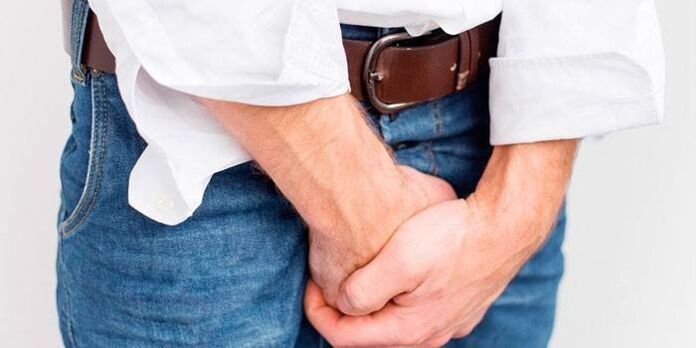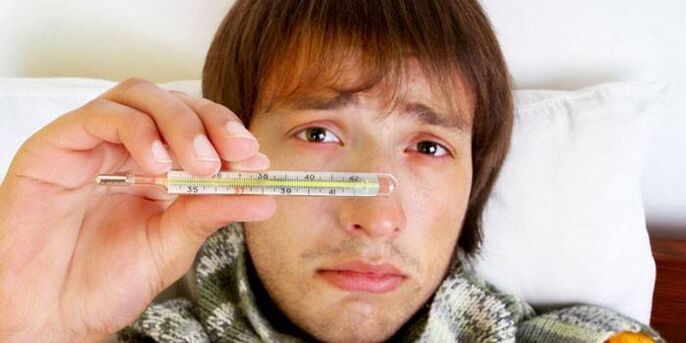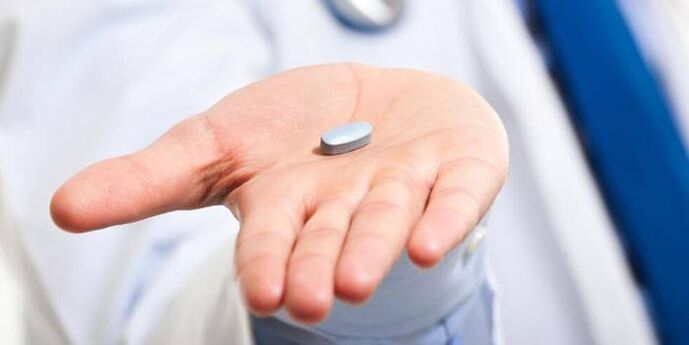Every second man of reproductive age (under the age of fifty) is prone to such a delicate disease as acute prostatitis, in which, under the influence of certain factors, inflammation of the prostate (prostate gland) occurs, leading to various forms of sexual disorders. Functions, fertility and psycho-emotional state. Be attentive to what your body is saying and do not neglect timely treatment.
What is acute prostatitis
If a man feels discomfort and even pain when urinating, you should immediately consult a doctor, because acute prostatitis is a disease of infectious etiology, which causes inflammation of the prostate, followed by swelling of glandular tissue, the formation of purulent foci. On it. If you do not pay attention to the signs of acute inflammation of the prostate, then the pathological process can turn into a chronic form, which is difficult to treat and the reflection time is very short - the transformation takes place in a few days.
However, more serious complications are possible than its transition to a chronic form. There is a risk of sepsis - general infection of the blood and ascending infection of the urinary tract with the development of pyelonephritis and cystitis. In such cases the patient is urgently hospitalized, the condition can be critical. Although sepsis as a complication is rare, it can occur in immunosuppressive states - intoxication, fever, severe symptoms, weakness. Therefore, blood cultures are needed to detect microorganisms.
Symptoms of acute prostatitis
Every man should know and remember the symptoms of acute prostatitis. General signs of the disease are revealed:
- Acute pain when urinating.
- Intoxication of the body.
- Disorders of urination (intermittent, weak, tense flow).
- Frequent desire to visit the toilet at night.
These are external symptoms of prostatitis, but on closer examination, leukocytes were found in the urine, with traces of mucus and pus in the secretory fluid of the prostate gland. On palpation it feels like a dense, enlarged body, the catch will be painful. Further development of the inflammatory process is characterized by heaviness and pain in the perineum, which radiates to the penis, sac and rectum. As a result, the patient has difficulty emptying and defecating due to severe pain. Body temperature can rise to 38 degrees.

Causes of acute prostatitis
As this disease is bacterial inflammatory in nature, the following infectious agents are the causes of acute prostatitis:
- Gram-negative - Klebsiella, E. coli, Proteus.
- Gram-positive - enterococci, staphylococci, streptococci.
- Urogenital - trichomoniasis, chlamydia, urethroplasmosis, gonorrhea, candidiasis, mycoplasmosis.
The microbial microflora penetrates the prostate glandular tissue, usually transcanalically (through the ducts separating the urethra and prostate gland). In cystitis, the infection travels from the bladder to the prostate. Other possible ways for bacteria to penetrate are opened during endorethral manipulations (catheter insertion, urethral buccal incision, cystoscopy, urethroscopy). Pathogenic microorganisms are transmitted to the prostate from distant pathogenic foci of caries, sinusitis, tonsillitis, cholecystitis, pyoderma, bronchitis.
There is a high probability of infection from the intestines with proctitis, hemorrhoids, colitis. Non-infectious factors that can lead to an attack of prostatitis are a congestive (congestive) venous phenomenon in the pelvis and impaired drainage of the glandular ascites. Swelling can be caused by irregular or, conversely, excessive sexual activity, cessation of sexual intercourse, sedentary lifestyle, frequent constipation, frequent alcohol intoxication, varicose veins of the pelvis, hypothermia.
Forms of acute prostatitis
The clinical development of this disease is considered in three stages, which are simultaneously forms of acute pancreatitis. This is:
- The first stage is the catarrhal form.
- The second stage is the follicular form.
- The third stage is the parenchymal form.
Acute prostatitis in men begins with catarrhal inflammation, which is characterized by enlargement of the acin, swelling of the glandular tissue, and, consequently, an increase in body size. The inflammatory process actively involves the secretory ducts of the prostate gland, which open into the posterior urethra. The lobules and ducts of the prostate gland become inflamed, their contraction is broken down, narrowed and closed, this can complicate the secretion of the prostate secretion.
In the catarrhal stage, the pathological process stops in the mucous layers and does not deepen. In the process of progression the disease spreads to the entire prostate gland. Follicular acute bacterial prostatitis develops. Pus comes out during urine analysis. Glandular tissues change destructively, swelling increases. The follicular form is still subject to relatively simple treatment.
In addition, a parenchymal form of the disease develops, which can result in a prostate abscess, or chronic prostatitis. Therefore, symptoms such as:
- Increase in body temperature to 39 ° C and above.
- Manifestations of intoxication: weakness, chills, thirst, lack of appetite.
- Frequent rushing to the toilet for a small need is accompanied by sharp sharp pains.
- Inability to empty the bladder.
- Flatulence.
- Tennessee.
- Constipation.
- Mucus discharge from the anus.

Diagnosis of acute prostatitis
At the first suspicion of prostate inflammation, hurry to the doctor. Correct and comprehensive diagnosis of acute prostatitis is very important for rapid and successful treatment. The doctor first analyzes the history, finds out when the pain sensations appear in the perineum, increases or decreases during ejaculation, urination, defecation. Make sure the doctor examines the patient's medical history: what diseases were transmitted, whether there were sexually transmitted infections.
Urology by palpation of the external genitalia will identify developmental pathologies, visible signs of prostatitis and examination of the rectum - palpation of the prostate gland through the anus. The following examinations will be needed to create a complete clinical picture:
- Urine analysis to determine the level of leukocytes and the presence of purulent filaments.
- ხBlood test.
- Culture smear - The contents and urethra are removed to determine the growth of bacteria and their susceptibility to antibiotics.
- Determination of urinary velocity (uroflowmetry).
- Ultrasound of the prostate to detect diffuse changes in the gland and the formation of its abscess.
- Blood test to determine the presence of pathogens of diseases such as syphilis, gonorrhea, mycoplasmosis, chlamydia.
- PCR diagnostics.
Treatment of acute prostatitis
After a thorough diagnosis, treatment for acute prostatitis is started. It is based on antibiotic therapy aimed at suppressing infectious pathogens. In addition, conservative treatment of prostatitis includes:
- Anti-inflammatory drugs.
- Remedies that improve blood circulation.
- Painkillers and antispasmodics.
- Drugs that stimulate metabolic processes in the prostate gland.
- Multivitamins.
- Phytotherapeutic agents.
- Immunomodulators.
Advanced forms of inflammation of the prostate with the appearance of purulent foci require surgical intervention. Transurethral (through the urethral wall) or transrectal (through the anus wall) drainage of abscessed areas is performed. In case of abnormal urinary retention surgery may be required. Puncture epistystomy is performed - a wound is made in the abdomen, in which a tube is inserted to transport urine.

Drugs
Treatment of acute prostatitis in men with medications (tablets, injections) is the basis of successful therapy. With well-prescribed antibiotic therapy, the infection can be overcome in a few days. However, in order to completely eliminate the pathogenic microflora, it is recommended to continue treatment for four weeks. Medications used during the disease are:
- Etiotropic (antibiotics) - destroys pathogens.
- Pathogenetic (nonsteroidal anti-inflammatory drugs) - eliminate prostate swelling.
- Symptomatic (painkillers, antipyretics) - relieves pain, muscle spasm of the body and other symptoms.
For the treatment of prostate inflammation, your doctor may prescribe a complex of medications that includes:
- Injections - helps the drug to penetrate into the tissues of the body in a short time.
- Candles (rectal) - analgesic, antibacterial effect.
- Instillations - Delivery of the drug into the prostate by opening the urethra.
- Microclisters with herbal decorations.
- Antibacterial drugs with a wide range of action, unless a specific cause of the disease is identified.
Antibiotics for acute prostatitis
The main causative agent of prostatitis is pathogenic bacteria that cause inflammation in the tissues of the prostate gland. Therefore antibiotics for acute prostatitis are the basis of treatment and are prescribed only after checking the susceptibility of the microflora. Antimicrobials used for inflammation are divided into the following groups:
- Fluoroquinolones.
- Penicillins.
- Cephalosporins.
- Macrolides.
- Tetracyclines.
- Aminoglycosides.
Prevention of acute prostatitis
In order for a man to be always healthy, full of energy, it is important to prevent acute prostatitis, including:
- Regular sex life with a regular partner, excluding casual relationships.
- Using a condom.
- Stop smoking, drugs, alcohol.
- Proper nutrition.
- Personal hygiene.
- Annual prophylactic examinations with a urologist.
- Taking vitamins and zinc supplements.
It is important to completely cure diseases of the genital organs (urethritis, cystitis, pyelonephritis, balanoposthitis). Untreated diseases can lead to the development of an inflammatory process in the prostate gland. Among other things, we should not forget to increase physical activity. Hypothermia should be avoided during the cold season. Prostate massage is very beneficial for men's health. However, if the disease has already been felt, massage is contraindicated and even impossible due to body pain.




























